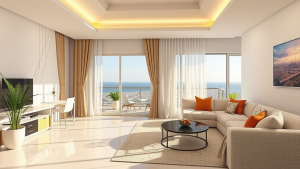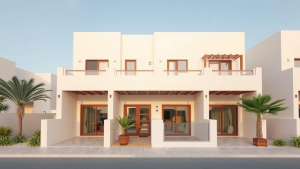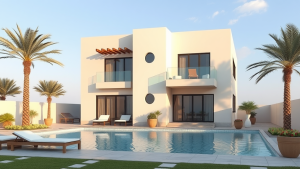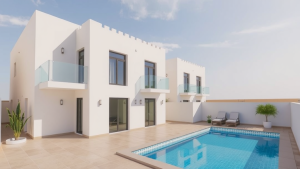Key accessible housing features every retiree should consider
As you reach retirement age, it’s essential to think about your living environment. Accessible housing features are crucial for maintaining independence and comfort as you age. Understanding what to consider will help you make informed decisions about your living situation.
Wider doorways and hallways
The first step in creating an accessible home is ensuring that doorways and hallways are wide enough. This is especially important if you use a wheelchair or walker. Standard doorways can be narrow, making navigation difficult. Aim for a width of at least 36 inches for doorways and hallways. This allows for smooth transit throughout your home without feeling cramped.
Single-level living
Choosing a single-level home or an apartment can greatly enhance accessibility. Stairs can pose a significant risk for falls and injuries, particularly for seniors. If you prefer a multi-story home, consider installing a stairlift. However, a single-level layout eliminates the need for stairs entirely, making movement more manageable.
Zero-entry showers
Bathrooms can be particularly challenging spaces for seniors. Consider a zero-entry shower, which allows you to step in without having to navigate a high ledge. This type of shower can significantly decrease the risk of slips and falls. Adding grab bars around the shower and toilet can further enhance safety.
Lever-style door handles
Using lever-style door handles is another excellent feature to look for in accessible housing. These handles are easier to operate than traditional knobs, especially for those with arthritis or limited hand strength. You might also want to consider touchless faucets in the bathroom and kitchen. They offer convenience and can minimize the need for physical contact.
Lower countertops and storage
Adjusting the height of countertops and cupboards can make daily tasks easier. Look for homes that feature lower countertops in kitchens and bathrooms. This adjustment can help you prepare meals or conduct daily hygiene routines without straining. Pull-out shelves or drawers in cabinets also improve access and convenience when reaching for items.
Smart home technology
Investing in smart home technology can significantly enhance accessibility in your home. Features like voice-activated lighting, smart thermostats, and automated door locks can make day-to-day living much more convenient. These technologies can often be controlled via a smartphone or tablet, adding an extra layer of ease to your environment.
Proper lighting
Good lighting is essential for ensuring safety and preventing accidents. Natural light is paramount, so choose a home that maximizes this with large windows. Additionally, utilize bright, warm-toned light fixtures in key areas like hallways, staircases, and entrances. Motion-sensor lights can also be beneficial—helping you navigate safely without needing to fumble for switches.
Accessible outdoor spaces
If you enjoy spending time outside, consider housing options that provide accessible outdoor spaces. This could include features like ramps instead of stairs leading to patios or gardens. Level surfaces can also prevent falls and allow you to enjoy your outdoor space comfortably.
Emergency features
Having safety options in your home is daunting yet essential. Install easy-to-access emergency buttons in key rooms. This feature allows for quick assistance in case of a fall or other emergencies. Consider having a medical alert system that ensures help is only a button press away.
Ensuring your living environment meets your needs as you retire is vital for maintaining a fulfilling lifestyle. By considering essential accessible housing features, you can create a safe and comfortable home that allows you to age independently. Emphasizing convenience in your living space is not just about aesthetics; it is about enhancing the quality of life.
Benefits of aging in place: adapting your home for longevity
As people age, many prefer to remain in their homes instead of relocating to assisted living facilities. This preference is often referred to as “aging in place.” By adapting your home for longevity, you can enjoy both independence and safety. Here are several essential aspects to consider when making your home more accessible as you age.
Understanding the concept of aging in place
Aging in place means living in your own home, enjoying familiar surroundings, while having the necessary support to meet your changing needs as you get older. Some benefits of this approach include:
- Familiarity: Staying in a known environment helps maintain a sense of comfort and security.
- Cost-effective: It can be more affordable than moving to a different living facility.
- Independence: You can maintain your daily routine and lifestyle choices.
- Emotional well-being: Being in familiar spaces can positively impact mental health.
Essential housing features for aging in place
Adapting your home to meet your needs as you age can significantly enhance your quality of life. Here are features to consider when making your home more suitable for aging in place:
1. safe and accessible entrances
Ensure that your entrances are safe and easy to access. Consider the following:
- Install ramps instead of stairs for easy entry.
- Add handrails alongside steps and entrances.
- Ensure doorways are wide enough for wheelchairs or walkers.
2. functional bathroom modifications
The bathroom can pose significant challenges for seniors. To enhance safety and accessibility:
- Install grab bars near the toilet and in the shower or bathtub.
- Consider a walk-in shower instead of a bathtub.
- Use non-slip mats to prevent falls while getting in and out.
3. kitchen adaptations for easier movement
The kitchen should be a place of joy, not frustration. Changes you can make include:
- Rearranging frequently used items to lower cabinets for easier access.
- Installing pull-out shelves for better visibility and reach.
- Using lever-style faucets that are easier to operate with limited hand strength.
4. improved lighting for enhanced safety
Proper lighting is crucial to prevent accidents at home. Here’s how to improve it:
- Add brighter bulbs in all rooms, focusing on areas that are frequently used.
- Install motion-activated lights in hallways and entry points.
- Ensure that light switches are easily accessible, possibly at wheelchair level.
5. smart home technology
Integrating smart home devices can significantly improve your living conditions. Think about:
- Smart doorbell cameras that enhance security without needing to open the door.
- Automated lighting that you can control with your voice or smartphone.
- Medical alert systems that ensure help is just a button press away.
Planning for the future
While you may feel healthy and mobile now, it is essential to think ahead. Implementing adaptions can help maintain your independence. Start by identifying areas of your home that may benefit from modifications. Consult with professionals who specialize in aging in place or home safety to tailor your approach to your specific needs.
These features into your home can provide a seamless blend of comfort and accessibility. It allows you to age gracefully, surrounded by the memories and comfort of your home. Take the time to assess and adapt your living space for a more secure and independent future.
Decisions about adapting your home now can save you time and trouble later. Focusing on ease and safety will not only improve your daily life but will also offer peace of mind to you and your loved ones. Aging in place is not just about living longer; it’s about living well.
For retirees, making informed decisions about accessible housing features is crucial for enhancing comfort and ensuring safety as they age. Prioritizing aspects like wide doorways, non-slip flooring, and easily reachable light switches can significantly improve mobility and independence. Such thoughtful adaptations allow you to navigate your space with ease and peace of mind, reducing the risk of accidents that can lead to serious injuries.
Choosing to age in place not only promotes emotional well-being but also fosters a sense of belonging in a familiar environment. When you adapt your home to meet your changing needs, you create an atmosphere that encourages longevity. Simple changes, such as installing grab bars in bathrooms or opting for lever-style door handles, can make a substantial difference in everyday life. These enhancements promote self-sufficiency and discourage unnecessary reliance on caregivers, empowering you to maintain quality of life.
Ultimately, investing in accessible housing features is more than just a practical choice—it’s about uplifting your lifestyle and safeguarding your future. By embracing the concept of aging in place and making your home more accessible, you equip yourself with the tools to navigate life’s challenges seamlessly. Prioritize these modifications now to create a living space that not only meets your current needs but also adapts gracefully as those needs evolve. This foresight enables you to enjoy your retirement years with confidence and comfort, truly making it a time of fulfillment.
Last offer – luxury 3 bedroom standalone villa in hadaba Hurghada with garden under 150k — exclusive living for dutch retirees
18% discount – 5 bedroom standalone villa with swimming pool in hadaba Hurghada under 200k — stylish homes for german investors












